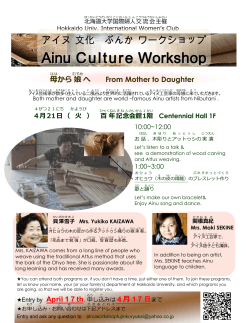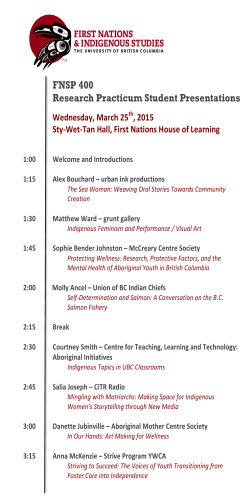
the slides - Human Rights Research and Education Centre
2015/3/25 Hokkaido University National Chengchi University Taiwan Indigenous Culture Park 3 2 4 2015/3/25 Parliament resolution to urge the government to officially recognize the Ainu as an indigenous people of northern Japan in June 2008. In response, the Chief Cabinet Secretary* expressed the government’s position: The government will not only enhance the Ainu policies taken so far, but will also make efforts to establish comprehensive policy measures. Definition and legal implication of indigenous people was unclear and countries supporting U.N. Declaration would seek to implement it within their respective frameworks of domestic law. Seeking policies that would best suit the Ainu and the country’s domestic state of affairs, the Chief Cabinet Secretary established the Advisory Council for Future Ainu Policy in August 2008 to develop a comprehensive policy framework. Behind these was “the United Nations Declaration on the Rights of Indigenous Peoples” adopted in September 2007. *Chief Cabinet Secretary ranks next to the Prime Minister and the main function is to coordinate the ministries and agencies and to serve as the 5 government's spokesperson 6 Ainu assumingly 50,000 in Hokkaido, another few thousand in Tokyo and elsewhere. 0.05% of total population No tribal settlements Amis tribe, the largest group in Taiwanese Aborigines Taiwan Aborigines population 530,000 2.2% of total population 16 recognized tribes Mr. Yang Dai-Kang, Amis player in a Japanese Professional Baseball Team 7 8 2015/3/25 Basic concept behind 2009 report of the Advisory Council for Future Ainu Policy; “The national government has a great responsibility to take sufficient measures to ensure the revival of indigenous Ainu culture, taking into consideration the historical context of how the modernization of Japan under national policy seriously damaged their culture.” Ainu Policy Measures until 2008 ・Improvement of Living Standards Hokkaido Ainu Welfare Measures by Hokkaido Prefectural Government ・Cultural promotion Measures by the Foundation for Research and Promotion of Ainu Culture under Ainu Culture Promotion Act of 1997 Living Conditions Survey 2008 survey showed the ratio of Ainu households receiving public assistance was 2.5 times the national average. The college entrance rate among Ainu under 30 was half the national average. General meeting of the Advisory Council at the Prime Minister's Official Residence 9 THE “PROCESS” ORIENTED CONCEPT OF INDIGENOUS PEOPLE: This concept focuses not directly on the sovereignty or the rights of the ethnic group but on the process by which they were forced into minority status in their own territory. It views this process as the reason why the national government’s obligation of policy consideration should be weightier for indigenous minority than for other minorities such as immigrants. THE SUBSTANTIVE or “RIGHT” ORIENTED CONCEPT OF INDIGENOUS PEOPLES: The term indigenous peoples refers to ethnic groups that enjoy quasi-sovereign status and related rights, such as right to selfgovernment or special representation in national legislature and right to the land they’ve traditionally owned or occupied, as outlined in the U.N. Declaration. In Taiwan, 6 out of 113 seats of national legislature are reserved to aborigines, and they can prove aboriginal status by the official household registration The government is obligated to restore Ainu culture in broader sense. This Concept does not fit the present situation of the Ainu and the Japanese society issues of rights owners/collective rights/sovereign rights 10 New Ainu theatre at Lake Akan in Eastern Hokkaido 11 12 2015/3/25 Article 13 of the Japanese Constitution, which stipulates, “All people shall be respected as individuals,” could embrace respect for individual’s choice of lifestyle. If Ainu people choose to maintain their ethnic identity, this must be respected. From 2010, under the supervision of the new Ainu Policy Promotion Council headed by Chief Cabinet Secretary, the government’s implementation of specific policies recommended in the final report started. Government should create an environment in which the Ainu language and lifestyle will be handed down so that Ainu descendants can maintain their ethnic identity. It’s difficult to express ethnic identity if discrimination remains, so the government has to eliminate prejudice. Those policy measures include; (1) The Symbolic Space for Ethnic Harmony, and (2) Measures for the betterment of living and educational conditions. The Advisory Council concluded if the principle of creating a society in which the Ainu can maintain their ethnic identity and pride can be established on Article 13 of the Constitution, policies requested by the Ainu can mostly be implemented. Meeting of the Ainu Policy Promotion Council: 5 among 12 members are Ainu 13 Purpose of the Symbolic Space for Ethnic Harmony is to create a national institution where Ainu and other Japanese people can learn together about the history and culture of the Ainu so that related information can be passed on to future generations. 14 HOKKAIDO *Sapporo *Shiraoi The Space should have a range of facilities, including a national museum, traditional houses and modern handicraft studios; be based on a land with a beautiful natural environment and include functions to foster practitioners of Ainu language, traditional crafts and dance; promote exchanges with indigenous peoples around the world. The Symbolic Space for Ethnic Harmony to be located on Poroto lake at Shiraoi town Grand opening will be in 2020 15 16 2015/3/25 Chickasaw Cultural Center, Oklahoma Polynesian Cultural Center, Hawaii TAIWAN INDIGENOUS PEOPLES CULTURE PARK 2015/3/25 Policy measures for the betterment of living and educational conditions under supervision by Working Group for Policy Promotion include; the scholarship for Ainu students, a subsidy program for universities where the history and culture of the Ainu are studied, and a counseling system for livelihoods and employment. Efforts are also under way to teach Ainu history and culture in school education, promote activities to spread Ainu culture, implement a project to foster practitioners of Ainu language and traditional crafts, establish a system to protect traditional knowledge, create facilities for Ainu people to interact, and return the human remains of Ainu people. Methods to certify Ainu ethnicity is under consideration. Concepts of “being indigenous” and policy framework in the context of Ainu People (1) The basic policy framework for ethnic minority. The government should develop environments that enable Ainu people, as an ethnic minority, to keep their ethnic identity as ordained by the Article 13 of the Japanese Constitution which reads “All people shall be respected as individuals.” But this rationale applies not only to Ainu people but every other ethnic minority including Koreans and Chinese residing in Japan. 21 22 If Japan’s first set of indigenous policies based on the process oriented concept of indigenous people results in an increase in the number of Ainu who embrace their ethnic identity and the promotion of public understanding for the Ainu, the future generation of the Ainu and majority of Japanese society will have choice of choosing next step of Ainu policy which may include the substantive or “right” concept of indigenous peoples. (2) Adding weight on indigenous minority The process oriented concept of indigenous people views that the national government’s obligation of policy consideration should be weightier for indigenous minority than for other minorities because of the historical process that the state entered the minority’s territory without consent and adversely affected their culture under a national policy. Accordingly the government has a much heavier obligation to revive the Ainu culture in wider sense. Governor of Hokkaido and U.S. Ambassador Kennedy in Ainu dress 23 24
© Copyright 2025









